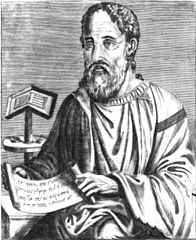
An Ecclesiastical History To The 20th Year Of The Reign Of Constantine by Eusebius
CHAPTER XXV
THE PERSECUTION UNDER NERO, IN WHICH PAUL AND PETER WERE HONOURED WITH MARTYRDOM IN THE CAUSE OF RELIGION AT ROME
NERO now having the government firmly established under him, and henceforth plunging into nefarious projects, began to take up arms against that very religion which acknowledges the one Supreme God. To describe, indeed, the greatness of this man’s wickedness, is not compatible with our present object; and as there are many that have given his history in the most accurate narratives, every one may, at his pleasure, in these contemplate the grossness of his extraordinary madness. Under the influence of this, he did not proceed to destroy so many thousands with any calculation, but with such indiscriminate murder as not even to refrain from his nearest and dearest friends. His own mother and wife, with many others that were his near relatives, he killed like strangers and enemies, with various kinds of death. And, indeed, in addition to all his other crimes, this too was yet wanting to complete the catalogue, that he was the first of the emperors that displayed himself an enemy of piety towards the Deity. This fact is recorded by the Roman Tertullian, in language like the following: “Examine your records. There you will find that Nero was the first that persecuted this doctrine, particularly then when after subduing all the east, he exercised his cruelty against all at Rome. Such is the man of whom we boast, as the leader in our punishment. For he that knows who he was, may know also that there could scarcely be any thing but what was great and good, condemned by Nero.” Thus Nero publicly announcing himself as the chief enemy of God, was led on in his fury to slaughter the apostles. Paul is therefore said to have been beheaded at Rome, and Peter to have been crucified under him. And this account is confirmed by the fact, that the names of Peter and Paul still remain in the cemeteries of that city even to this day. But likewise, a certain ecclesiastical writer, Caius by name, who was born about the time of Zephyrinus bishop of Rome, disputing with Proclus the leader of the Phrygian sect, gives the following statement respecting the places where the earthly tabernacles of the aforesaid apostles are laid. “But I can show,” says he, “the trophies of the apostles: for if you will go to the Vatican, or to the Ostian road, you will find the trophies of those who have laid the foundation of this church, and that both suffered martyrdom about the same time. Dionysius bishop of Corinth bears the following testimony, in his discourse addressed to the Romans. ‘Thus, likewise you, by means of this admonition, have mingled the flourishing seed that had been planted by Peter and Paul at Rome and Corinth. For both of these having planted us at Corinth, likewise instructed us; and having in like manner taught in Italy, they suffered martyrdom about the same time.’ ” This testimony I have superadded, in order that the truth of the history might be still more confirmed.
Copyright ©1999-2023 Wildfire Fellowship, Inc all rights reserved

 Keep Site Running
Keep Site Running